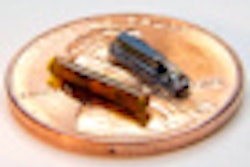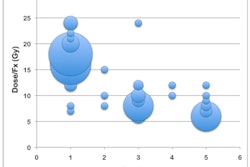CHICAGO - Prostate cancer patients who undergo brachytherapy treatments that fail due to inadequately placed radioactive seeds -- but who don't develop distant metastases -- may have better luck the second time around, concluded a study presented at the RSNA meeting.
Approximately 10% of men who receive interstitial brachytherapy treatment for localized prostate cancer experience prostate-specific antigen (PSA) deprivation failure, and up to 20% may experience biochemical failure within 15 years following treatment.
There currently is no consensus regarding the optimal management of these patients whose failure remains localized and who do not develop distant metastases, said Steven Campbell, a fourth-year medical student at the University of Kentucky College of Medicine.
Treatments include androgen deprivation therapy, which works well for a short period of time but not long term. Experimental treatments include cryotherapy and high-intensity focused ultrasound (HIFU). Salvage radical prostatectomy represents one extreme treatment, with unpleasant side effects. Proactive observation may be the best option for elderly men whose life expectancy is estimated to be less than 10 years.
Repeating localized interstitial brachytherapy may be a viable option, however, for men who were underseeded during the initial procedure, according to the study. Campbell reviewed nearly a decade of medical records, from 2001 through 2010, to identify appropriate patients who had undergone a salvage localized brachytherapy procedure. He identified a total of 19 men, and analyzed their outcomes and toxicities from the treatment.
"The hypothesis of the university's radiation oncologists was that patients who had a relatively 'cold' or underseeded area of the prostate had, within those spaces, nests of cancer cells responsible for their local recurrences, as evidenced by rising PSAs," he said. "Thus, if we could reseed just those spots, we should be able to knock out their recurrence with minimal toxicity."
The patients who agreed to try this initially were diagnosed at a median age of 50, with an age range of 41 to 71 years. When their PSA nadir was followed by three successive rises or they had a PSA rise greater than 2 ng/mL above the nadir value, they had a median age of 65 and an age range of 46 to 75 years.
At the time of original treatment, 68% had a Gleason score less than 6 and a median PSA of 6.4 ng/mL. At the time of salvage treatment, the median PSA for the group was 3.49. Fourteen of the patients originally had iodine-125 (I-125) monobrachytherapy, three also had external-beam radiotherapy, and two had palladium-103 (Pd-103) monobrachytherapy. Twelve of the patients had had their original treatment at the University of Kentucky.
For the second treatment, all had I-125 seeds implanted in target areas that were identified as underseeded. The dose administered ranged from 108 Gy to 144 Gy.
"There were, of course, more patients treated at our institution who experienced localized biochemical failure," Campbell said. "However, they were excluded from being offered this treatment if their oncologists and radiation oncologists felt that additional seeds were not going to be of any benefit. In our opinion, these patients had received an adequate dose."
To determine eligibility for salvage brachytherapy, all patients underwent a bone scan as well as a CT exam of the abdomen and pelvis to rule out metastasis. Images from the CT examination were carefully scrutinized to assess the seed distribution in the prostate. For qualified candidates, a transrectal ultrasound was performed to generate a target value for focal prostate brachytherapy.
The median interval between the first implant and the second implant was 74.3 months. However, the range of time varied significantly, from as soon as 19 months to 24 years.
Six patients out of the 19 subsequently experienced another localized biochemical failure, defined as the PSA nadir plus 2 ng/mL. The mean time to failure was 16.5 months, but failure occurred as soon as 12 months following salvage brachytherapy to as late as eight years. Only one patient developed a Radiation Therapy Oncology Group (RTOG) grade 2 toxicity.
"As the number of prostate cancer patients who elect brachytherapy treatment increases, and currently the numbers are skyrocketing, we are going to need a better way of dealing with the inevitable failures that are going to occur," Campbell said. "Our small, single-institution study review showed good control rates with good toxicity outcomes. The failure of the majority of the patients to return to their baseline International Prostate Symptom Scores appeared to be due more to poor follow-up than anything else. We determined from this study that patients may feel that seeing their urologist or general practitioner is adequate."
The radiation oncology department plans to contact all of its prostate brachytherapy patients to obtain their urinary status, in the hope of reducing the biochemical failure rate with this intervention.



















